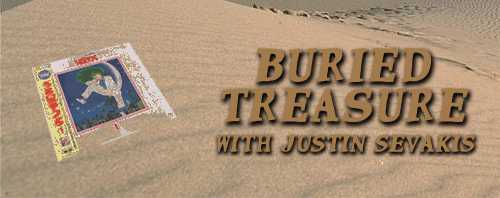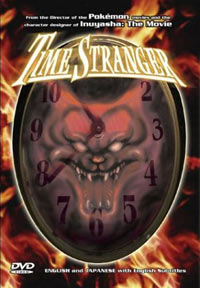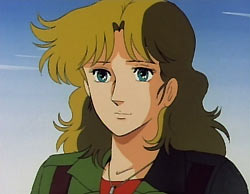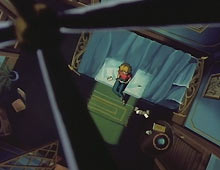Buried Treasure
Time Stranger
by Justin Sevakis,

Time Stranger
(AKA: GoShogun: The Time Étranger)
 Time Stranger (original title: Goshogun: The Time Étranger), by all accounts, should be an easily dismissible relic of anime history. It was made in 1985 and looks like it. It's the “final movie” to a largely forgotten mecha series, Sengoku Majin GoShogun. It's also directed by Kunihiko Yuyama, who shows up on IMDB for being the helmer behind the Pokémon anime.
Time Stranger (original title: Goshogun: The Time Étranger), by all accounts, should be an easily dismissible relic of anime history. It was made in 1985 and looks like it. It's the “final movie” to a largely forgotten mecha series, Sengoku Majin GoShogun. It's also directed by Kunihiko Yuyama, who shows up on IMDB for being the helmer behind the Pokémon anime.With lineage like that, the show is a hard sell at best. And yet, it's so startlingly compelling and deeply affecting that, on a purely emotional level, it rivals anything Satoshi Kon ever did.
I first saw Time Stranger way back in the mid 90's, on a whim. I instantly fell in love with it, and as I've come back to it over the years I keep finding more layers I hadn't noticed before. I've written about it, I've edited promos, I've licensed it for television... all in an effort to get other people to see it. But it's just so quirky, its plot so difficult to describe, that I feel I'd probably have an easier time convincing Museum of Modern Art to screen it than an anime club.
I've not seen the Goshogun TV series, but the movie feels so perfect on its own merits that I'm reluctant to tamper with the experience. Suffice it to say, GoShogun tracked the exploits of a group of three pilots and their large robot -- a woman named Remy Shimada and her co-pilots Shingo Hojo and Killy Gagley. Fighting a war against a powerful criminal organization, they won the support of the three opposing generals, Suegni Cuttnal, Yatta-La Kernagul, and Leonardo Medici Bundle, who then joined their "GoShogun Team" to defeat the organization they once supported.
Now the movie, far from being a stereotypical kids' romp, turns into a surreal ode to the team's one female character, while in the process removing all of the mecha from the story. Instead, it looks deeply at its characters, and asks an unusual question: what did they do afterward? The war is over, they're retired -- what do they do with the rest of their lives? The answer here is surprisingly realistic: after being awarded the Galaxy Award (which Remy turned down) they've gone their separate ways. However, they do see each other occasionally, and the story picks up as they're about to gather for their 40th reunion. ("You mean you two never hooked up?" Killy asks Shingo, as they wait for Remy to show up.)
 Remy's time is running out, and she knows it. Over seventy years old, she has a chronic and fatal disease, and as she feels the end approaching, she races to meet her two old friends one last time. Circumstances decide otherwise. A rather spectacular car wreck later, she's in critical condition, and her old teammates stand beside her, wondering what to make of her condition.
Remy's time is running out, and she knows it. Over seventy years old, she has a chronic and fatal disease, and as she feels the end approaching, she races to meet her two old friends one last time. Circumstances decide otherwise. A rather spectacular car wreck later, she's in critical condition, and her old teammates stand beside her, wondering what to make of her condition.A majority of the film is flashback. We see to Remy's distant childhood, including a mother figure straight out of Les Miserables. But more revealing is a separate GoShogun story that runs alongside the other main plotline, one in which the entire team was trapped inside a surreal Middle-Eastern town, in which the entire population revolts against them like zombies as they try to defy the fate that has been laid out in front of them: They will all die horrible, brutal deaths within a few days.
The harbinger of fate is a little girl riding a panther, and together they greet the doomed party in their hotel rooms to show them gruesome snapshots of their impending demise. Remy is first, and so as her scheduled day of death draws near, the rest of her team tries to help her escape, with little success. The town seems cursed: attempt to leave and you'll end up either dead (the townspeople don't tolerate those who try to fight their fate) or you'll get zapped right back where you started. The two stories parallel each other nicely: Fate decides that Remy will die. Remy decides otherwise, and fights fate kicking and screaming.
Remy is something we don't normally see in anime: a real tomboy. She's confident, strong, and can hold her own amongst the guys. She's not an object of fan service, doesn't dress sexy, and doesn't whine. She's not the leader of the team per se, but she's easily the most important. Buried throughout the flashbacks are small pieces of charm that give us real insight into Remy and her complexities. In one early scene we see the top of her dresser, on which is a lipstick and several bullets, which look almost identical next to each other. Her vanity license plate reads "SEE YOU AGAIN", which we learn later is a slogan of hers. We realize, this woman was the constant in the lives of five men engaged in a brutal war and continually came out of the most demanding situations unscathed. In their lives, she lies somewhere between mother figure and God: an untouchable pillar of support. And now, as their God (we never see her aged face) lies comatose and dying in front of them, their entire system of belief comes into question.
 This tired quest for happiness and adoration for friends and would-be lovers reminded me of Fellini, specifically his film 8 ½, or so I wrote when I reviewed this film on DVDFile.com many years ago. Nowadays, I see more of Ingmar Bergman (specifically his film "Wild Strawberries") in its fanciful and at times desperate analysis of life, death and loneliness. It's endlessly heartwarming in its admission of how important friends are.
This tired quest for happiness and adoration for friends and would-be lovers reminded me of Fellini, specifically his film 8 ½, or so I wrote when I reviewed this film on DVDFile.com many years ago. Nowadays, I see more of Ingmar Bergman (specifically his film "Wild Strawberries") in its fanciful and at times desperate analysis of life, death and loneliness. It's endlessly heartwarming in its admission of how important friends are.Coming back to Time Stranger in today's political climate, I also see what a damning portrayal of Muslim extremism it is. Though I imagine some will take offense, it's important to note that it's not an indictment of the faith itself; what's depicted is sort of a fantasy Islam, more exotic obscurity than anything else. There are very few Muslims in Japan, and most of the population had just learned about it on the news and in the documentary series "Silk Road" that had aired the previous year. Rather, what's criticized is blind resignation to what they see as the will of God, to the point where they will willingly die trying to kill in his name. It's portrayed as, frankly, sub-human madness. Though many of the locals are killed by the heroes as they're trying to escape, they're not judging; in fact, they even entertain what they say might be true. But they're trying to live.

The English dub is another Arlen Tarlofsky work from his studio Mercury Productions, and it's one of his better, albeit not exemplary. Veronica Taylor is absolutely perfect as perky-but-mature Remy. Other performances are more or less spot-on, although some supporting performances are a little shaky. While the Japanese verison is excellent as well, the better audio quality in the English version makes it a toss-up as to which I prefer. The music is a rare orchestral score reminiscent of classic Hollywood. Also notable are the two vocal tracks, one of them an extremely powerful ballad to Remy, and the other, "Nighttime Merry-Go-Round" shamelessly rips off the Hall & Oats song "Out of Touch." Despite that distraction it's used pretty effectively.
Once, while I was working at CPM, I was assigned to cut a trailer for Time Stranger. I was overjoyed – to be able to work on a film I respected so much was a rare luxury. I selected about 45 minutes of footage to work from, which is quite a lot, and sat down, trying to do the work justice.
After three days of editing, I gave up. I couldn't do it. The footage looked old and boring. The story sounded odd and nonsensical. The voice-over I had recorded didn't sound quite right. The music from the show was all too inappropriate for a trailer, so I had to use some lame stock music we had lying around. But more than that, I couldn't wrap my head around what made the film so great. Maybe I knew, but I sure as hell didn't know how to articulate it in a trailer.
Years later, when it came time to license stuff to show on ImaginAsianTV, I jumped at the chance to license Time Stranger, with the hope that I could share it with somebody – even one person – that would be as moved by it as I was. When I started my research for this piece, I found this review on IMDB, dated July 30, 2006:
“I am an old man and I've seen a million movies. I don't like anime… But late last night I saw "Time Stranger" on TV. I've been in hospital beds, opiated, nearly dying, and the depiction of Remy's dreams, living in the past, the present and the future all at once was startlingly familiar. Her fortitude, her courage, chambering her last round, tying the gun to her broken hand in the face of monstrous certain death, never giving up, never giving in, to the fight outside or to the struggle within herself! I wept when it ended.”
It's stuff like this that makes it all worthwhile.
I made an old man cry at a cartoon.
| Obscure-O-Meter™ | |
| A | Abundant. Available anywhere that carries anime. |
| C | Common. In print, and always available online. |
| R1 | US release out of print, still in stock most places. |
| R2 | US release out of print, not easy to find. |
| R3 | Import only, but it has English on it. |
| R4 | Import only. Fansubs commonly available. |
| R5 | Import only, and out of print. Fansubs might be out there. |
| R6 | Import long out of print. No fansubs are known to exist. |
| R7 | Very rare. Limited import release or aired on TV with no video release. No fansubs known to exist. |
| R8 | Never been on the market. Almost impossible to obtain. |
| Adapted from Soviet-Awards.com. | |
How To Get It:
Central Park Media's DVD seems to be the only version in print, which is fine, because it's a very good disc, and quite inexpensive. The video has been carefully DVNR'ed, and though it could use a new transfer, it looks pretty darn good in its current shape. There's a separate song and sign subtitle track, as well as a nice synopsis of the original Goshogun TV series… and of course, my crappy crappy trailer, preserved for all to see. An earlier version, released under the original title by NuTech, was produced from CPM's subtitled VHS master. The quality is OK, but why bother when a much better version is available so cheaply?
Another dubbed version was produced on VHS only by Manga Video UK. I haven't seen this version, but would very much like to, since I've always had a soft spot in my heart for Manga UK dubs. I imagine their unique style might lend an interesting feeling to the film. Seen it? Let me know how it is in the forums!
The original GoShogun TV series was edited together with an unrelated show, Aku Dai-Sakusen Srungle, and badly dubbed into something both unrecognizable and incomprehensible called Macron 1. A few volumes were released on VHS, but unless you enjoy bad 80's hack-dubs, I recommend you stay far away.
SPECIAL SECTION! Secrets of Anime Production
Today's Episode: Why do movies from the 70's and 80's sound so bad?
Those who watch lots of 80's anime will notice a recurring pattern: the Japanese audio track sounds REALLY bad. This really only holds true for movies. TV shows still sound decent, as do OAV's. But almost every anime feature made before 1986 or so sounds muffled, flat and in really loud moments, completely distorted. The English dubbed versions, on the other hand, sound fine.
The reason has more to do with how movies were made back then than anything else. Back in the old analog days of sound design, editing and mixing was done on something called "mag film". Mag film was basically film stock with a magnetic tape layer on it, and it was used as audio tape running at the same speed as the film.
The process of doing sound design on mag is almost unbelievable in today's digital world. Literally, every audio track was a separate reel of mag, spliced with garbage film stock used for filler. Whenever a sound effect or a piece of music needed inserting, a splice was made so that the piece of mag with that audio recorded on it ran through the editor at the same time as the film. If more than one sound effect played at once, another whole reel of mag was necessary. It wasn't unusual for larger productions to have 20 or more reels of mag, all running simultaneously and in synchronization with the film.
Mag film is actually very good quality. That wasn't the problem. The problem was, in order to be played back in theaters, all of the various tracks of mag had to be mixed together, then encoded into an optical waveform. That waveform was then printed onto the side of the finished film print, which would be read by the projector in a theater.
The trouble is, that optical waveform could really only hold so much data, and the amount of data is far less than what the human ear can hear. By today's standards, it's like if movies could only hold a 32 kbps MP3 file. Sounds awful, but that's all there was room for. Additionally, since the audio was affected by the light that could be passed through the film, any dirt or scratches or natural grain on the film would make the sound noisier. It sounded great in the late 1920's, when the standard for optical audio was ratified, but by the 80's, it sounded pretty bad.
The background hiss was so bad, especially during quiet moments, that theaters would often just turn down the treble, which made everything sound muffled. To compensate, audio engineers cranked UP the treble when they did their mastering, which made everything on high frequencies distort like crazy.
In the early 70's, Dolby Labs invented a way to eliminate the noise from that audio, and even add additional data for speakers in the back. They called their new format "Dolby Stereo". It was a huge revelation for motion picture audio. In the late 80's, Dolby further enhanced this technology and called it Dolby SR (or "Spectral Recording"). Nowadays, most movies are encoded in Dolby SR Digital, which is 5.1 audio for theaters. Other technologies, such as DTS (which used separate audio CD's that syncronize with the picture) and SDDS (Sony's competing format) have also been introduced. Simplified versions of Dolby SR-D and DTS have been incorporated into the DVD standard.
But Japan was somewhat slow to catch on with these new technologies, so while anime with Dolby encoding was released as early as 1985, many theaters couldn't really make much use of it until many years later. Many lower-budget productions never even bothered. Worse, the final mixed audio for most recordings were seldom saved in any format other than the optical audio. So it's that distorted, compressed trashy audio we're left with today.
But the music and effects tracks (M&E's), those dialogue-free mixes that are used to make dubs, were archived separately, on quarter-inch reel-to-reel tape. Those still sound pretty good to this day, although due to the nature of analog, they often lose sync with the picture, which can make dubbing a nightmare.
Some audio studios attempt to breathe new life into those old optical audio tracks with noise reduction, equalization and other modern digital processes. However, the time it takes to enhance these audio tracks is so long and so expensive and the result so unpredictable that most companies don't bother.
Screenshots ©1985 Tokuma Shoten/Ashi Productions. Licensed through IDO International. All rights reserved.
discuss this in the forum (42 posts) |